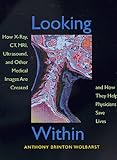Looking Within: How X-Ray, CT, MRI, Ultrasound, and Other Medical Images Are Created, and How They Help Physicians Save Lives
Looking Within: How X-Ray, CT, MRI, Ultrasound, and Other Medical Images Are Created, and How They Help Physicians Save Lives

A hundred years ago, a doctor had no way to look within the body of a patient other than to slice it open. That changed radically at the turn of the century, with the discovery of X-rays. X-ray and other forms of diagnostic imaging technology developed slowly but steadily from then until the 1970s, at which point a revolution occurred. Made possible largely by the availability of powerful but inexpensive computers, the rapid and widespread adoption of computed tomography (CT) and, a decade later, of magnetic resonance imaging (MRI) greatly expanded the power of clinical imaging, and even changed the ways in which physicians view and think about the human body.
This unique guide explains how the principal imaging devices work and how they help physicians save lives. It gives readers a grasp of the major medical technologies that might come to play important roles in their lives, and it provides succinct, easy-to-understand, and reliable explanations for those who wish to explore the issues of the associated benefits, costs, and risks in an informed manner. In nonspecialized language, Looking Within discusses how X-ray, fluoroscopic, CT, MRI, positron emission tomography (PET), ultrasound, and other medical pictures are created, and explores the essential roles they play in the diagnosis and treatment of patients. It should be of interest to patients and their friends and loved ones, and to those who are simply curious about this vitally important, exciting, and cutting-edge branch of medicine. Its brief but clear descriptions of how these essential tools work should also be of value to health care providers in supporting and educating their patients.For most of human history, our bodies have been inscrutable, accessible only to exterior or postmortem examination. But over the past hundred years, we've found tricky ways of viewing our bones, brains, and unborn children and thus greatly enriched our health. Medical physicist Anthony Brinton Wolbarst celebrates this revolution in Looking Within, an intriguing survey of medical imaging from the early days of Roentgen to the latest developments in thermography and functional magnetic resonance imaging. Writing for a general, if well-educated, audience, he guides us through the century by explaining the theories underlying each imaging technique as applied to real cases: broken bones, tumors, and heart disease all make their presence known through increasingly sophisticated technology.
The images, both reproductions and explanatory diagrams, are top-notch, lending a visual balance to the text that carries the reader through even when Wolbarst (rarely) gets a bit too technical. His experience with the National Cancer Institute and the Environmental Protection Agency broadens his range of understanding of the effects of radiological imaging on our lives, making his explanations more cogent and practical. Whether you want to gain insight into that ultrasound you have coming up or you simply want to marvel at the miracles of modern medicine, Looking Within will help you see what's really going on--just like a shoe store fluoroscope. --Rob Lightner

List Price: $ 26.95
Price: $ 13.79
No comments:
Post a Comment